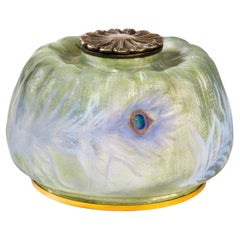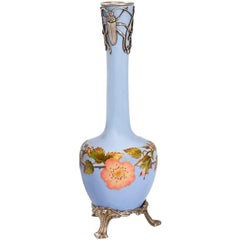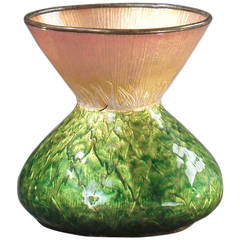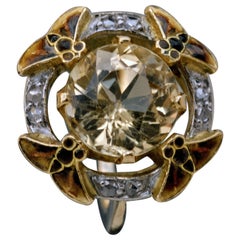Eugene Feuillatre
Eugène Feuillâtre "Pavot" Inkwell
By Eugène Feuillatre
Located in New York, NY
This stunning enamel, silvered metal, and gilt metal "Pavot" inkwell by Eugène Feuillâtre features
Category
Early 20th Century French Art Nouveau Inkwells
Materials
Metal, Enamel
Feuillatre Art Nouveau Silver and Enamel Vase
By Eugène Feuillatre
Located in New York, NY
A French Art Nouveau silver and enamel vase by Eugène Feuillatre. The vase is decorated with leafed
Category
Early 20th Century French Art Nouveau Vases
Recent Sales
Feuillatre Eugene "Artichaut Fleuri" Art Nouveau Vase, Signed
By Eugène Feuillatre
Located in Monte Carlo, MC
Copper and translucent enamel diabolo vase, the lower part is decorated with green enamel and gold artichoke leaves. The upper part is decorated with pink enamel. Signed.
Identic...
Category
Antique Early 1900s French Art Nouveau Vases
Materials
Copper, Enamel
EUGÈNE FEUILLÂTRE An Art Nouveau Gold, Topaz and Diamond Insect Ring circa 1900
By Eugène Feuillatre
Located in London, GB
A beautiful and exceptionally rare topaz, diamond and enamel ring, signed Feuillatre. Designed with
Category
Antique Early 1900s European Art Nouveau Cocktail Rings
Materials
Diamond, Topaz, Gold, 18k Gold
Feuillatre Art Nouveau Citrine Plique-a-Jour Enamel Gold Brooch
By Eugène Feuillatre
Located in New York, NY
famed enamelist Eugène Feuillâtre. The brooch depicts four honeybees with interlaced antennae offering
Category
Antique Early 1900s French Art Nouveau Brooches
Materials
Citrine, 18k Gold
French Art Nouveau Plique-à-Jour Enamel and Silver Vase by Descomps
By Joe Descomps Cormier
Located in New York, NY
by Eugene Feuillatre.
This vase features semi-translucent green and blue plique-à-jour enamel
Category
Antique Early 1900s French Art Nouveau Vases
Art Nouveau Dragonfly Brooch
By Eugène Feuillatre
Located in New York, NY
Stunning Art Nouveau dragonfly pin (attributed to Eugene Feuillatre) mounted en tremblant, its
Category
Antique Late 19th Century French Brooches
Materials
Diamond, Platinum, 18k Gold
Art Nouveau Plique a Jour Enamel Brooch in Silver, Probably Pforzheim
Located in PARIS, FR
about it, René Lalique, Eugène Feuillâtre, Henri Vever, etc. In Japan, this technique is known as
Category
Vintage 1910s German Jugendstil Brooches
Materials
Silver, Enamel
People Also Browsed
Striking Art Nouveau Ceramic and Bronze-Mounted Vase in Victor Horta Style
By Victor Horta
Located in Lisse, NL
Top condition and pure elegance Art Nouveau vase.
For the collectors of museum quality and condition Art Nouveau ceramics. This stunning Art Nouveau vase is decorated with the mos...
Category
Early 20th Century European Art Nouveau Vases
Materials
Bronze
$2,890
H 10.75 in W 5.25 in D 4.4 in
French Baroque Style Wrought-Iron Stained Glass Hall Lantern, 19th-20th Century
Located in Los Angeles, CA
A French 19th-20th century Baroque Revival style wrought iron and four-color vitreaux stained glass single-light hall lantern, the rounded four stained glass panels with red, green, ...
Category
Antique Early 1900s French Baroque Revival Lanterns
Materials
Wrought Iron
$3,465 Sale Price
30% Off
H 27.5 in W 17.25 in D 17.25 in
19th Century Chinese Canopy Wedding Bed
Located in Marbella, ES
This is a wonderful example of a canopy bed from Shanghai Province, China. Made of Chinese Northern Elm, this bed features hoofed feet and multiple floral carvings.
The exterior ...
Category
Antique 19th Century Chinese Beds and Bed Frames
Materials
Gold Leaf
Venetian Monumental Seated Bird Cage
Located in Queens, NY
Italian Venetian style (20th Cent) octagonal shaped painted and decorated metal and wood bird cage with 8 upholstered seat and back cushions around base. (Franco Zefferelli Collection)
Category
Early 20th Century Italian Rococo Bird Cages
Materials
Metal
Beautiful Heavy Crystal Table Lamp, 1970s, France
Located in New York, NY
Beautiful heavy crystal table lamp, 1970s, France
Twisted crystal base and heavy, approx. 7 pounds.
28 inches to top of shade, 15 inches to top of crystal base, 7 inches diameter bo...
Category
Vintage 1970s French Mid-Century Modern Table Lamps
Materials
Crystal
Liceu de Artes e Ofícios. 19th Century Daybed
Located in Sao Paulo, SP
This recamier/daybed was conceived and executed with utmost quality and expertise, showing a style that incorporates many influences from the eigtheenth and ninetheenth century. Made...
Category
Antique Late 19th Century Brazilian Romantic Chaise Longues
Materials
Wood
Cobalt Blue Diamond Murano Glass Mirror, In Stock
Located in Miami, FL
Cobalt blue diamond cut Murano glass mirror, in stock
Vivid and intense cobalt blue glass block with naturally occurring air inclusions throughout
Highly polished faceted pattern...
Category
21st Century and Contemporary Italian Mid-Century Modern Wall Mirrors
Materials
Brass
Chesterfield Sofa in White Vinyl Upholstery
Located in New York, NY
Chic and stylish tufted white vinyl Chesterfield loveseat sofa on wood bun feet. Overall excellent condition, showing only light wear to fronts of armrests, as pictured. Clean, origi...
Category
Mid-20th Century American Hollywood Regency Loveseats
Materials
Faux Leather
Zebra High Armchair with Kudu and Buffalo Horns
Located in Paris, FR
Armchair zebra high with structure in solid wood,
upholstered inside with real white buffalo skin,
upholstered outside with real zebra skin, tail
included, with armrest made in r...
Category
21st Century and Contemporary French Armchairs
Materials
Bronze
$53,465 Sale Price
20% Off
H 72.05 in W 38.59 in D 33.08 in
Elegant Crystalline Glaze Porcelain Vase, University City, Taxile Doat
By Taxile Doat
Located in Riverdale, NY
Elegant thrown porcelain vase with an expansive and vibrant aquamarine crystalline glaze on a sand colored base by master French ceramist Taxile Doat, from the University City Porcel...
Category
Vintage 1910s American Arts and Crafts Vases
Materials
Porcelain
$10,800 Sale Price
20% Off
H 5 in Dm 5 in
Émile Gallé "Grenouilles" Fruitwood Cabinet
By Émile Gallé
Located in New York, NY
This French Art Nouveau "Grenouilles" carved fruitwood cabinet by Émile Gallé features detailed and masterful marquetry depicting dragonflies and mushrooms in a lush, leafy landscape...
Category
Antique Early 1900s French Art Nouveau Cabinets
Materials
Beech, Fruitwood
Rene Lalique Piriac Vase Designed 1930 – Marcilhac 1043
By René Lalique
Located in Tunbridge Wells, GB
Heading : Rene Lalique Piriac vase – Marcilhac 1043
Date : Designed 1930
Origin : Wingen-sur-Moder. France
Bowl Features : Clear and frosted glass with moulded blue stained band of f...
Category
Early 20th Century French Art Deco Vases
Materials
Art Glass
Black Forest Walnut 4-Fold Screen
Located in Queens, NY
Rustic Black Forest (19th Century) walnut floral carved 4 fold screen with leopard style fabric upholstered panels.
Category
Antique 19th Century Rustic Screens and Room Dividers
Materials
Animal Skin, Walnut
Italian 19th Century Canopy Bed with Silver Friezes and Upholstered Purple Silk
Located in Firenze, IT
One of a kind canopy bed or day bed made up of two scrolled silver columns and upholsterd with an Italian vintage pure silk brocade.
Sourced in a private residence in Venice this 19...
Category
Antique 19th Century Italian Baroque Revival Beds and Bed Frames
Materials
Silver
$7,641 Sale Price
21% Off
H 80.71 in W 78.75 in D 58.27 in
French Mahogany Pascaud Scroll Game Table
By Jean Pascaud
Located in Queens, NY
French 1940s square mahogany game table with diamond design inlaid top and scrolled capital top on square tapered legs with bronze sabot feet. (attributed to JEAN PASCAUD)
Category
Vintage 1940s French Art Deco Game Tables
Materials
Bronze
Unbelievable Silk Embroidered Suzani
Located in Chicago, IL
An unbelievable late 19th century Kirman silk embroidered Suzani textile depicting two entwined trees-of-life with flowering branches and surrounded by multiple borders. Measures: 2'...
Category
Antique 19th Century Unknown Quilts and Blankets
Materials
Silk
Get Updated with New Arrivals
Save "Eugene Feuillatre", and we’ll notify you when there are new listings in this category.
More Ways To Browse
Rams Head Inkwell
Silver Capstan Inkwell
Silver Mounted Horse Hoof
Silver Travelling Inkwell
17th Century Inkwell
1930s Birmingham Silver
Antique Brass Inkwell Pen Holder
Antique Porcelain Figural Accessories
Black Forest Cat Inkwell
Brass Cherubs Inkwell
Bronze Cat Inkwell
Dog Head Inkwell
Figural Bronze Inkstand
Geschutzt Inkwell
Inkpot 19th Century
M Bertin
Meissen Inkwell
Ormolu Ink Well



